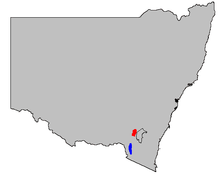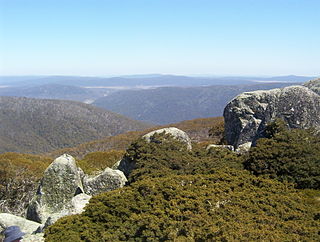
Namadgi National Park is a protected area in the south-west of the Australian Capital Territory (ACT), bordering Kosciuszko National Park in New South Wales. It lies approximately 40 kilometres (25 mi) southwest of Canberra, and occupies approximately 46 percent of the ACT's land area.
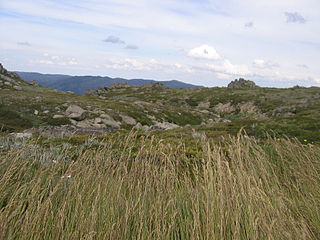
The Australian Alps montane grasslands is a montane grassland ecoregion of south-eastern Australia, restricted to the montane regions above 1300 metres .

The giant burrowing frog or eastern owl frog is a large frog species that occurs in coastal south-east New South Wales and Victoria in Australia. It is also known as the owl frog, southern owl frog, spotted owl frog, burrowing owl frog.

The Baw Baw frog is a critically endangered species of Australian frog as categorised on the IUCN Red List and listed under the Flora and Fauna Guarantee Act (1988), endemic to Baw Baw National Park. It has suffered a decline in population, mostly due to infection caused by chytrid fungus. Zoos Victoria has undertaken a breeding program to ensure survival of the species which commenced in 2010, and in October 2018 successfully collected the first eggs laid in captivity.
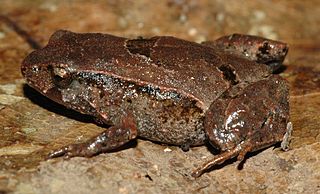
The pouched frog, or hip pocket frog, is a small, terrestrial frog found in rainforests in mountain areas of south-eastern Queensland and northern New South Wales, Australia. It is one of two species within the genus Assa, the other being Assa wollumbin and is part of the family Myobatrachidae.

Rheobatrachus, whose members are known as the gastric-brooding frogs or platypus frogs, is a genus of extinct ground-dwelling frogs native to Queensland in eastern Australia. The genus consisted of only two species, the southern and northern gastric-brooding frogs, both of which became extinct in the mid-1980s. The genus is unique because it contains the only two known frog species that incubated the prejuvenile stages of their offspring in the stomach of the mother.
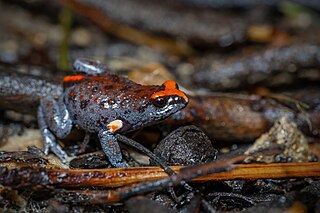
The red-crowned toadlet is a species of Australian ground frog, restricted to the Sydney Basin, New South Wales. It is only found around sandstone escarpment areas around Sydney, from Ourimbah in the north, Nowra to the south and the Blue Mountains areas to the west.

The Bibron's toadlet or brown toadlet is a species of Australian ground-dwelling frog that, although having declined over much of its range, is widespread through most of New South Wales, Victoria, south-eastern Queensland, and eastern South Australia, including Kangaroo Island. Bibron's toadlet settles in a wide variety of habitats within these region but they mainly reside in dry forests, woodland, shrubland, grassland, coastal swamps, heathland, and sub-alpine areas. They deposit their eggs in leaf litters during the flooding season, which is essential for the proper development of the egg. This species has high sexual dimorphism within the species and utilizes chemosignals to attract potential mates.

The tusked frog is a species of ground-dwelling frog native to eastern Australia from Eungella National Park, Queensland south to Ourimbah, New South Wales. It is the only species in the genus Adelotus - adelotus meaning "unseen" and brevis meaning "short".

Philoria is a genus of frogs native to eastern and southern Australia. These frogs are all confined to mountain areas, with 7 species occurring in the mountains of northern New South Wales and southern Queensland. One species occurs in Victoria. All species are listed as endangered, except the Baw Baw frog, which is listed as critically endangered. They are small to medium-sized frogs that live in water saturated sites, such as sphagnum bogs and seepages on rocky slopes. The eggs are laid in foam nests hidden from light. The tadpoles remain within the nest and live entirely on the yolk.

The Booroolong frog is a species of stream-dwelling frog native to the Great Dividing Range in New South Wales, Australia. It is a member of the Hylidae, or the "tree frog" family. The Booroolong frog is classified by the IUCN as a Critically Endangered Species.

Amphibians of Australia are limited to members of the order Anura, commonly known as frogs. All Australian frogs are in the suborder Neobatrachia, also known as the modern frogs, which make up the largest proportion of extant frog species. About 230 of the 5,280 species of frog are native to Australia with 93% of them endemic. Compared with other continents, species diversity is low, and may be related to the climate of most of the Australian continent. There are two known invasive amphibians, the cane toad and the smooth newt.

Spicospina is a genus of ground-dwelling frogs in the family Myobatrachidae. It is monotypic, being represented by the single species, Spicospina flammocaerulea, also known as the sunset frog. First discovered in the year 1994, it is native to south-western Western Australia. It is known from only 27 sites, all occurring east and northeast of Walpole.

The smoky mouse is a species of rodent in the family Muridae native to southeastern Australia. It was first described in 1934 and its species name is Latin for "smoky". As its name suggests, it is a grey-furred mouse, darker grey above and paler smoky grey below. Mice from the Grampians are larger and a darker more slate-grey above. It has a black eye-ring and dark grey muzzle. The feet are light pink, and the ears a grey-pink. The tail is longer than the mouse's body, and is pink with a brownish stripe along the top. Mice from east of Melbourne average around 35 grams and have 107 mm long bodies with 116 mm long tails, while those from the Grampians are around 65 grams and have 122 mm long bodies with 132 mm long tails.

The magnificent brood frog or magnificent broodfrog is a species of frog in the family Myobatrachidae. It is endemic to Queensland, Australia, and is known from near Ravenshoe in the southern Atherton Tableland and from Mount Spec in the Paluma Range. The specific name covacevichae honours Jeanette Covacevich, an Australian herpetologist.

Mount Gingera is a mountain with an elevation of 1,857 metres (6,093 ft) AHD located within the Brindabella Range on the border between the Australian Capital Territory and New South Wales in Australia. The summit of the mountain is located within the ACT, and is the second highest peak in the territory.
The Ginini Flats Wetlands Ramsar Site, also known as the Ginini Flats Subalpine Bog Complex, is a wetland in the Australian Capital Territory (ACT) that has been recognised as being of international importance by designation under the Ramsar Convention. It was listed on 11 March 1996 as Ramsar Site 793, and is the only such site in the ACT. It lies in the Australian Alps, close to the boundary of the ACT with New South Wales.
The northern corroboree frog is a species of Australian ground frog, native to southeastern Australia. It is differentiated by the southern corrboree frog by having slightly narrower and greener stripes, while also being smaller. Northern corroboree frogs live in waterlogged grasslands and adjacent woodlands. Northern corrboree frogs spend most of their time in the woodlands, going to the waterlogged grasslands in the summer to breed. Females lay around 25 eggs in damp vegetation, and hatch when water levels rise. The northern corrboree frog is listed as critically endangered and has decreased massively, due to chytrid, weeds, droughts, climate change, and livestock.

The southern corroboree frog is a species of Australian ground frog native to southeastern Australia.
The Mount Ballow mountain frog is a species of frog in the family Limnodynastidae. It is endemic to eastern Australia, straddling the border of Queensland and New South Wales. It is known only from the central and western McPherson Ranges, in the Gondwana Rainforests World Heritage Site.

